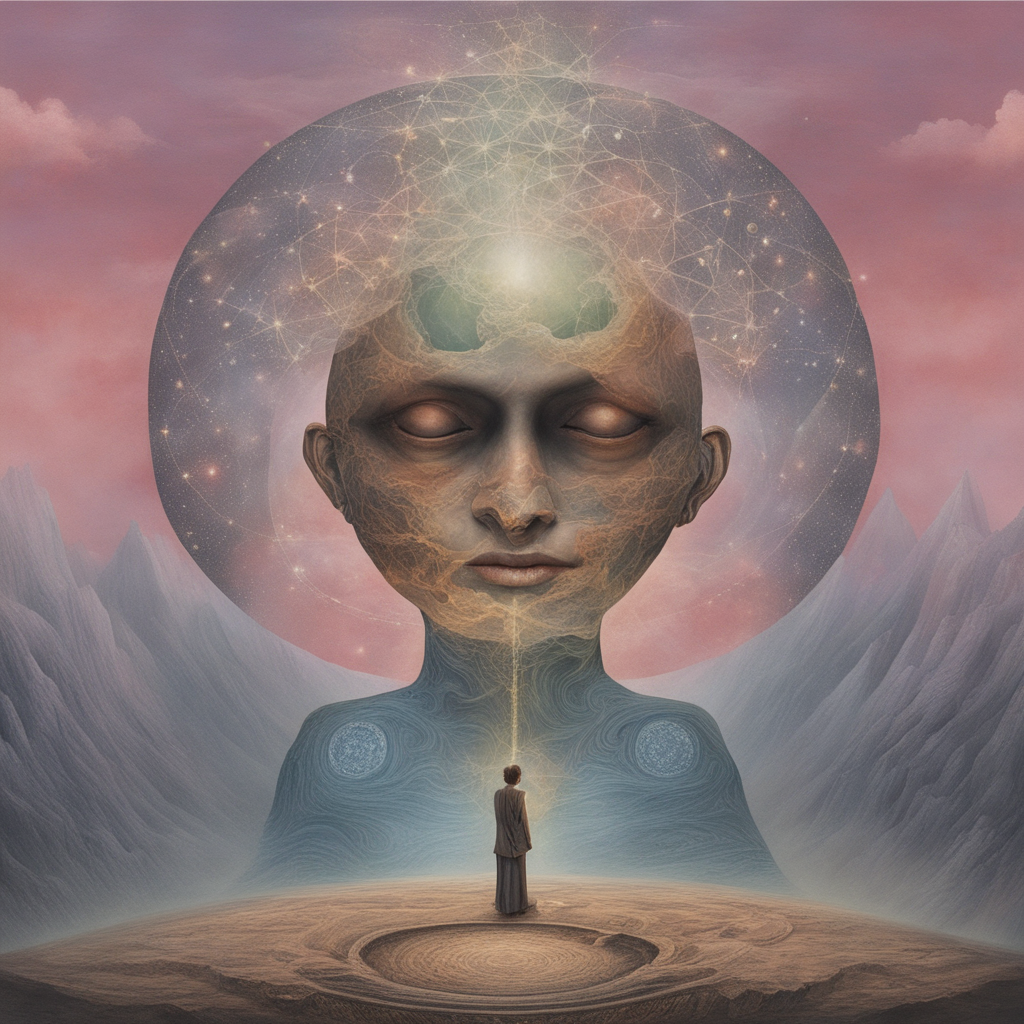We can’t solve neurotic self-contradiction on the level at which the results of this self-contradiction are being experienced. That is a hierarchy of events no one can untangle! Furthermore, we experience the pain of neurotic self-contradiction without being aware that there is any contradictoriness going on – were we to see the contradiction, we would be free from it. When we can’t see the conflicted nature of what we are continually trying to achieve, we are bound to continually incur neurotic suffering, therefore. This is going to be a permanent state of being for us.
A simpler way of explaining this point is to say that neurotic pain is insoluble – no matter what a solution-focused therapist might claim to the contrary! Trying to solve something is thinking about it and thinking about it is trying to solve it if – we weren’t thinking about our situation then it wouldn’t seem to us that we need to solve it. The very word ‘solution’ gives the game away – in the Psychological Realm ‘looking for a solution’ is not a legitimate thing to do, despite what our culture tells us. Solving problems is a legitimate thing to do in the outside world, to be sure, but when it’s the inner world we’re talking about then trying to find a solution is simply resistance. We are trying to escape from our situation, and that inevitably involves us in a vicious paradox (or ‘logical regression’).
‘Escaping’ is the sensible thing to do when we find ourselves in a dangerous physical situation. If a bear is chasing us maybe we can climb a big tree. If the house is on fire and we can’t get to the door then we can jump out of the window. But if it’s something scary on the inside then trying to escape is only going to make matters worse. ‘What we resist, persists’, says Carl Jung. Running from my demons empowers them; fighting my demons (and solving the problem this way) also empowers them. ‘Solving the situation’ sounds so much more positive, so much more courageous and proactive, but ‘trying to find a way of dealing with my demons’ (and thereby solving that problem) empowers them just as much as running away from them does! There’s no difference – it’s just how we sell the idea to ourselves, it’s just the spin we put on it.
In the inner world fleeing and fighting are one and the same thing. Deliberately trying to ‘face our fears’ empowers them – I wouldn’t be trying to face my fears (or confront my demons) if I wasn’t frightened of them. I’m resisting the situation; I’m resisting the situation of ‘me being afraid of my demons’ and that this shows that I’m afraid of the situation. That’s why I’m trying to ‘reverse my attitude’ – I don’t like my fearful attitude and so I’m trying to change it. The point we’re making here therefore is that trying to change things ‘on the inside’ is always a manifestation of fear. If we weren’t afraid that we would be interested in what’s going on, we’d be curious about it. We would pay attention to it. It’s no good ‘only being interested in positive (or pleasant) developments’ because this is ‘fear in disguise’. New Age positivity is ‘fear in disguise’. It turns out that the positive state of mind that I’m interested in is only ‘positive’ to us because it represents an escape from the negative.
<Positive> is always the flip side of <negative> – we like the sound of ‘positive’ so we don’t see it as being merely ‘our automatic resistance to the negative’. The word itself seems to possess some kind of magic – it’s like a charm that will protect us from evil if we repeat it often (and fervently) enough. ‘Positive’ means that ‘the problematic situation has been solved’, it means that ‘all the bad stuff has gone away’. Only, it hasn’t gone away at all it’s just been flipped over into its opposite. It has been temporarily disguised, in other words; we’re playing some kind of cheap trick on ourselves, but it’s a cheap trick that we’re calling ‘a solution’. We’re relating to this sneaky little dodge of ours (the dodge where we ‘temporarily flip over the negative to make it into a positive’) as if it weren’t a quick fix that’s going that is going to reverse on us later on, but a final glorious victory over whatever bad thing it was that we didn’t want to deal with.
We are actually utilising this ‘dodge’ all the time in our everyday lives, it’s just that we don’t notice ourselves doing it. We notice ourselves ‘trying to achieve our goals’, we notice ourselves ‘striving to obtain the wonderful positive outcome’, but we don’t – most emphatically don’t – notice how this is just a cheap trick; we don’t notice that we’re ‘jumping onto a merry-go-round’ here. We don’t have any insight into what we’re actually doing, which is playing an endless delaying game, which is playing ‘the old, old game of postponement’. We’re being fooled and we’re fooling ourselves, both at the same time. The highly promoted idea that there is a solution, that there is a positive outcome that won’t flip over to become a negative later on, isn’t just ‘wrong information’, it’s a deadly trap that keeps us endlessly recycling the same bit of unreal time, it’s a revolving door which seems to be leading somewhere whilst actually ‘bringing us right back to where we started from’ every time. The ‘solution’ we’re fascinated by isn’t a solution at all, it’s simply a glitch.
When we put all the emphasis on ‘making progress’, on ‘achieving’, on ‘solving the problem’ (and so on) then what this means is that we’ve ‘opted for the appearance over the actual’, ‘the image over the content’. There’s no content here, no content at all – it’s all just a trick of the light. There’s absolutely nothing happening here but no one is allowed to point this out. To be driven by ‘the fear of seeing the big picture’ is to be locked into ‘the little picture’ and the little picture isn’t a real thing but only – as we have just said – empty theatre. The phrase ‘toxic positivity’ has entered our vocabulary over the last few decades but what we are looking at here goes far beyond what we usually understand by this term – our fascination with achieving the positive outcome paralyses us as it at the same time that it takes away every last bit of our natural intelligence. Our lives become sublimely counterproductive – everything we’ve got is invested in the ‘spinning wheel’, has been re-routed into the spinning wheel, with the result that all we can understand is the crass dichotomy of ‘stop versus go’, ‘do versus don’t’, ‘success versus failure’, which is utter nonsense. It’s ‘nonsense that we can’t see as such’; it’s ‘nonsense that the whole world (mental health services included) is forcing upon us’.
The key thing to see (which we don’t see) is that there are no escapes or solutions to what’s happening to us, and that when we do invest in escaping this only makes things worse this makes things worse not better. Saying that ‘investing in finding the solution makes things worse’ is a wholly inadequate way of expressing it – by investing everything we’ve got in fixing or escaping we turn ourselves into futile machines, incapable of doing anything other than ‘repeating the reflex’, incapable of doing anything other than ‘fighting counterproductively to solve the so-called problem’.
The very last thing we’re going to see is that the problem is ‘us trying to fix the problem’ and that – furthermore – ‘us trying to fix the problem’ is a problem that can’t ever be fixed. It’s not ‘something we can fix’, it’s an all-devouring paradox! We don’t like to hear about problems that can’t ever be solved – that’s not really our style, after all… To talk about problems that can’t be fixed is against our religion – the ‘Religion of Positivity’ (which is the Religion of Fear) strictly forbids any such talk. The impossibility of solving this particular problem ISN’T the terrible thing that it seems, however – what would be terrible is if we somehow succeeded in what we’re trying to do (since what we’re trying to do is ‘escape reality’). Reality itself is the error we are trying so desperately (and so counterproductively) to fix. ‘Life is not a problem to be solid, but a reality to be experienced’, says Soren Kierkegaard, and the thing about this is that life is made up of the parts we don’t like just as much as the parts that we do. There is no ‘picking and choosing’ to it, which is something that the thinking mind can have no comprehension of (since that’s all it can ever do).
Everything that happens to us is life – it can’t not be. ‘It’s all life, every bit of it’ , writes Kurt Vonnegut writes in his novel Breakfast of Champions. As far as our ‘external life’ is concerned, ‘picking and choosing’ is pretty much how it works – we choose what is advantageous and reject what is not. We choose wholesome food over poison, clean water over water that is contaminated. No one is going to say this is the wrong thing to do; no one is going to say that we should ‘never ever reject anything’! When it comes to the inner life however, it’s a different matter entirely – a different principle is at work here. The principle is that ‘if we reject or resist any part of the inner life then we will get well and truly stuck’; to insulate ourselves from one part of it is to insulate ourselves from all of it. To repress one feeling is to inhibit ‘our capacity to feel’ across the board. We are our own worst enemy, in other words, and so to be thwarted at every turn at what we’re trying to do by ‘a problem that we simply can’t get around’ isn’t the terrible news that we think it is…
Writing two and a half thousand years ago, Lao Tzu puts it like this –
Those who wish to embody the Tao should embrace all things. To embrace all things means first that one holds no anger or resistance to any toward any idea or thing, living or dead, formed or formless.
‘Solving problems’ (or ‘achieving goals’) is a Western thing. Or to put this another way, it’s a function of the left hemisphere, and the left hemisphere has become dysfunctional as consultant psychiatrist and philosopher Iain McGilchrist argues here –
An increasingly mechanistic, fragmented, decontextualised world, marked by unwarranted optimism mixed with paranoia and a feeling of emptiness, has come about, reflecting, I believe, the unopposed action of a dysfunctional left hemisphere.
This predominance of the left hemisphere isn’t ‘a problem to be solved’ however. As we keep saying, tying to fix the problem of ‘me always trying to fix the problem’ is a trap, an infinite logical regression. It isn’t a problem to be solved but a reality to become aware of….
Image credit – ancient-origins.net






